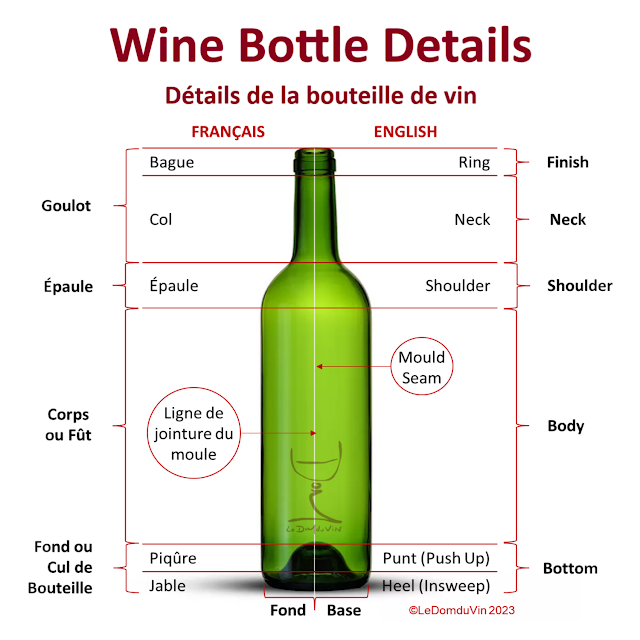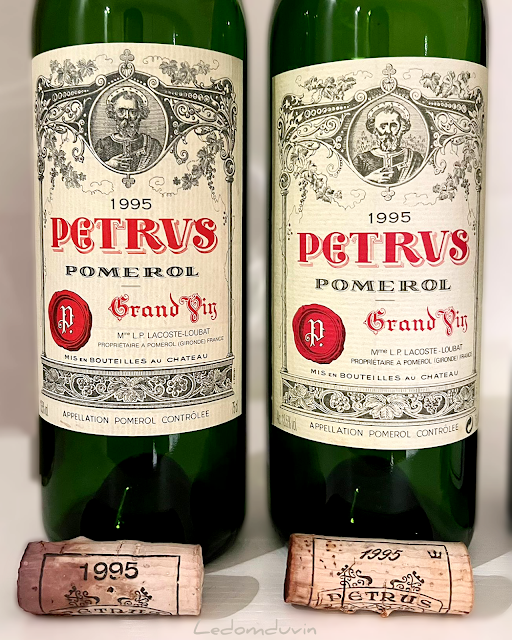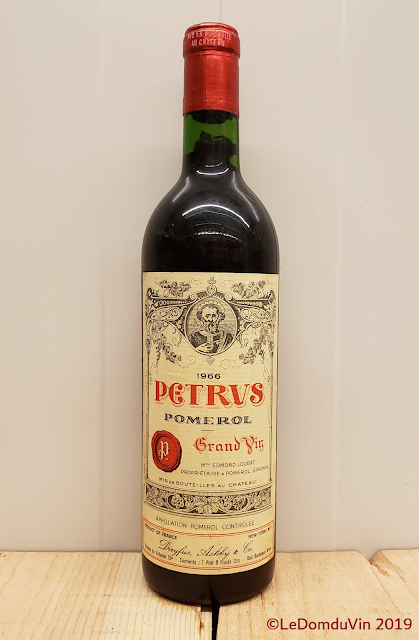Interpreting the engravings and markings located in the punt or at the bottom of a wine bottle.
In my previous job as a Wine Quality Control Director for nine years, I frequently received requests from people seeking my professional opinion, suggestions, or advice on specific aspects of the label or engravings on a particular bottle, often old and rare.
Even though I left that position two years ago, I still receive occasional inquiries from people who may doubt the authenticity of some of their bottles and are seeking answers.
When someone asks me a question, I prefer to respond privately. Yet, as I don't always have all the answers, I may need to research online, ask a specialist or consult books to find the information. Once I have the answer, I like to share it on my blog so others can benefit from my findings, particularly on obscure topics that are hard to find online.
I previously wrote a few posts on counterfeit and fake wine bottles, where I discussed the importance of bottle inspection and authentication, trying to answer as many of the questions most people may have (if interested, read them here, also here and here)
In these posts, I highlighted the significance of codes, bottle numbers, dates, and other markings engraved in the punt or at the bottom of a wine bottle. However, I never wrote a complete post about these topics, and it would be beneficial to do so.
I am writing this post in response to some questions I received about the markings found on 1960s bottles of Petrus. In the posts mentioned above (the 3 links), I have written quite extensively about Petrus. However, in this post, I will summarize what I already wrote about Petrus and delve deeper into the topic of the engravings and markings in the punt and at the bottom of the bottle.
The questions are regarding 2 separate case scenarios:
- A 1966 Petrus bottle with a bottle maker of "SG" at the "kick" that has a box around it.
- Has the label "SG" ever been present on a Petrus bottle from the 1960s or newer vintages?
- A 1969 Petrus bottle with a barely legible mark on the punt and a strange marking on the bottom right-hand corner of the label that appears to be a speck of red at first glance but looks like a heart shape under a microscope.
- Is there a specific marking on the bottle of 1969 Petrus?
- Is there a heart shape red spot at the bottom right-hand corner of the label?
Reminder: What is the "Punt"?
You may have noticed that the person who asked the question used the word "kick", which I prefer to call "the punt". Both words can be used to designate "the indentation" at the bottom of the wine bottle (as seen in the illustration below).
"The punt" was initially created by glassblowers by pushing up the bottle's seam to enhance its stability, strength and integrity, preventing it from wobbling when placed upright.
Then throughout history, "the Punt" has been given other meanings and usages, like:
- To ease the service of the wine, a spot to place your thumb while the rest of your fingers grab the base of the bottle while pouring it into a glass.
- To indicate the quality of the wine, the deeper, the better. Yet, it has never been proven. And nowadays, the depth of the punt does not seem to correlate with the quality of the wine whatsoever. It is just a bottle shape style, either standard from the manufacturer or at the client's request.
- To create an optical illusion that the wine bottle is bigger than it actually is. There again, difficult to tell when the bottle is full. And, when it is empty, well... no one cares about the punt, right?.
- To catch the falling sediment and allow them to easily gather at the bottom of the bottle. That may be true to a certain extent.
- To make the bottle sturdier and more pressure-resistant, especially for sparkling wines. That is true.
- To better organize and stack the bottle more efficiently, which is proven to be true when wineries stack their bottles on the ground, on shelves, on racks or in cages.
Reading the "Punt"
As you know, I like to draw and create images, collages and illustrations (and prefer doing things myself rather than taking someone else's work). So, as an image is worth a thousand words, here is an illustration to help you understand how to read the "punt" of the bottle.
Prelude
Before attempting to answer both cases, one thing must be said about Petrus: it is the most challenging and annoying wine to authenticate! Why? For decades, they have been inconsistent with their labels (colour, font, small details, etc...) and continue to be so (maybe a little less this past decade, but still...).
The differences between the Petrus labels of the same vintage on 2 different bottles can sometimes be bewildering. Even for a guy with years of experience, like me, it can be very challenging to authenticate them and know whether they are real or fake or if only one is real and the other is fake. And if so, which one? How to differentiate them? (check the links above in the introduction to have the answer)
Like this example of "Petrus 1995 or Petrus 1995?" (picture below) that I described in a previous post (if interested, read it here).
And the most annoying thing is that Petrus will never answer questions. I have tried countless times, in vain. In the past 12 years, I have sent them emails with questions about the label (and even the bottle) variations for the same vintage, and I'm still waiting for an answer.
Although I imagine details like these have probably been recorded somewhere, this may be due to their lack of knowledge or recollection (meaning they may not even know themselves or don't remember), especially for the older vintages that may have been released at different periods using slightly different labels printed using other printers, and maybe even printed for different markets.
For example, let's take 1961 Petrus. Part of the stock was first released about 2 years after harvest (in 1963) with a specific label. The leftover was kept in reserve at the Chateau for later release. Depending on the release time, they may have changed the printer and some details on the label.
Chateaux typically do not hold onto unused labels. Labels are ordered as needed and in specific quantities based on the number of bottles the chateau plan to release at a specific time. The remaining bottles are stored in the cellars without labels until an order is placed, which helps to prevent temptation and eventual theft both from within and outside of the chateaux.
If labelled in the 70s or the 80s, the label will definitely present variations compared to the original. Even more, if printed later on, in the 1990s and 2000s, as the paper used was slightly different and the printing techniques too. Same if it was relabelled later due to lousy label conditions, etc...
Like for example, these 3 bottles of Petrus 1961 present lots of differences on the labels (see picture below).
Looking at these 2 pictures above, you better understand why Petrus is the most challenging and annoying wine to authenticate!
If you do not have the correct references, as well as the know-how and necessary knowledge and experience, and unless you open the bottle to taste it, it can be challenging to differentiate a counterfeit from a real one sometimes or to even know which one is the real one if you end up mixing them.
And, although annoying and inconvenient, Petrus (and other highly-coveted brands like DRC, etc..) do not answer questions about the details of their labels and bottles for security reasons. It is perfectly understandable when you know that, depending on the vintage, the average market price for a bottle of Petrus is between 3,000 and 6,000 Euros. Petrus is among the world's top 10 most coveted and most counterfeited wines, with DRC, Lafite Rothschild, Penfolds, etc...
Therefore, better be discreet, not give any answers and refrain from divulging any information to anyone to prevent the leaking of valuable data and prevent counterfeiters from gaining access to these details. Caution is necessary.
However, now that I have set the "ambience" and put things into perspective with Petrus, let's try to answer these questions. 😁👍🍷
1966 Petrus
Although I have bought, opened, tasted, prepared and served (and occasionally drunk) and inspected many bottles of Petrus in my 32 years career as Sommelier / Wine Buyer, including 1966 (and older), I did not necessarily take close pictures of the details on the labels and/or the bottles and therefore lack pieces of evidence to correctly answer this question.
Searching online, I could not find any specific details about the punt of Petrus 1966.
However, a quick search on French glass and bottle manufacturers providing Bordeaux bottles to the chateaux during the 1960s resulted in a short list of some significant wine bottle makers in France, including the following:
1. Saverglass: Founded in 1897, Saverglass is a leading French glass manufacturer that produces high-quality bottles for various industries, including wine.
2. O-I (Owens-Illinois): Originally an American company, O-I has been in France for many years. They are one of the largest glass container manufacturers globally and have supplied wine bottles to French winemakers during the 1960s.
3. Saint-Gobain/Verallia: In 2010, the Packaging Sector of Saint-Gobain launched Verallia, a new international brand dedicated to manufacturing glass bottles and jars. However, Saint-Gobain has also produced glass bottles for the wine industry for over 3 centuries, besides providing materials distribution and services for construction companies. (***)
4. Verreries Brosse: Founded in 1875, Verreries Brosse is a well-known French glass manufacturer specializing in creating glass containers for wine, spirits, and other beverages.
5. BSN Glasspack: BSN Glasspack, now part of the Ardagh Group, was a significant player in the French glass packaging industry during the 1960s. They supplied wine bottles to wineries across France.
These are a few examples of France's significant wine bottle makers during the 1960s. There were likely other smaller manufacturers and regional suppliers as well.
As mentioned, I don't currently possess a bottle of 1966 Petrus, and my online search yielded little information. However, I did come across an article that confirms that the initials "SG" embossed either on the side or inside the punt of the bottle refer to "Saint-Gobain." (*)
Therefore, the answer is yes regarding the presence of the "SG" label on Petrus bottles in the 1960s. Petrus used bottles manufactured by Saint-Gobain, which featured the letters "SG" embossed within the punt of the bottle during that time period.
I am unsure if the initials "SG" were embossed in a box or square shape on bottles of 1966 Petrus, as I do not have one to verify. Even though more recent vintages of Petrus do not feature a box around the "SG" initials, it is possible that older vintages may have had initials or logos embossed within a circle or square shape.
Saint-Gobain's website (**) states they have produced glass since 1665. In 1692, a factory was established in the village of Saint-Gobain in Picardy, a region north of Paris. This factory eventually became part of Saint-Gobain and gave its name to the company.
Saint-Gobain is a significant company that operates in more than 60 countries. They are a global leader in light and eco-friendly construction and offer materials and services for both the construction and industrial markets, including glass for wine bottles. One of their essential business components is manufacturing glass containers such as bottles and jars. They are the second-largest producer of glass containers globally after Owens-Illinois, Inc. (O-I).
Talking about old markings embossed on bottles of Petrus, in a video about "Potentially Fake Petrus" bottles that I posted on YouTube about 3 years ago (see below), the bottle maker marking "CX" can clearly be seen at the bottom of the punt of the bottles from the late 1950s and early 1960s.
I couldn't find any information online about "CX" being embossed on old bottles of Petrus or Bordeaux. Perhaps I should start taking pictures and create a library of Petrus bottle details for future reference.
To address the second part of the 1st inquiry regarding the continued usage of "SG" on recent vintages and to ensure accuracy in my response, I visited the wine cellar of one of the restaurants belonging to the company I am employed with. I took several photographs of different Petrus vintages for verification purposes: 1982, 1989 and 1990.
Let's start with the 1982 vintage.
- The bottle maker marker: VOA (VOA- Verrerie d'Albi - France) (****)
- Volume - 75cl
- 55 mm (up to 63 mm) Gap length between the top of the bottle and the top of the wine fill level after filling exactly 75cl of wine in the bottle.
- And the number 03 (to the right of 55 mm) (numbers on the punt usually correspond to various identification numbers, like the "year manufactured" or "mould identification number". As this is a bottle from the vintage 1982, the number "03" cannot be the year manufactured, so I'm assuming it is the "mould identification number" in that specific case.
The Braille-like bumps on the heel and/or rings on the bottom are the bottle or the mould identification, readable by the inspection equipment for traceability (lot number, year of manufacture, code, etc...). Allowing for the defective lots and/or mould to be easily retrieved.
Each bottle manufacturer has its own way of coding the bottle, and it would be too long to develop all the different codes, numbers and letters. Moreover, this post was just to give you an idea of how to read the punt. For more details, please refer to the website links in the "Sources & References" paragraph at the bottom of this post.
Now let's answer the second batch of questions about Petrus 1969.
Petrus 1969
The person wrote: A 1969 Petrus bottle with a barely legible mark on the punt and a strange marking on the bottom right-hand corner of the label that appears to be a speck of red at first glance but looks like a heart shape under a microscope.
- Is there a specific marking on the bottle of 1969 Petrus?
- Is there a heart shape red spot at the bottom right-hand corner of the label?
There is no heart shape at the bottom right-hand corner of the 1969 Petrus label. One of the owners probably put it there as a joke due to the vintage connotation.
Voila! That's All, Folks! Stay tuned for more posts coming soon. In the meantime, as always, take good care of yourself and your loved ones, stay safe and enjoy life as much as you can while you can!
Cheers! Santé!
Dom
@ledomduvin #ledomduvin #punt #bottom #bottle #engravings #winebottle #bottleengravings #embosse #wine #vin #vino #wein #wineknowledge #wineeduction #sharing #knowledge #passion #education
Sources & References:
(*) Article mentioning the "SG" engraved/marked on bottles:
https://sha.org/bottle/makersmarks.htm
(**) Saint-Gobain history: https://www.saint-gobain.com/en/group/our-history
(***) Verallia: https://fr.verallia.com/s/reconnaitre-une-bouteille-verallia?language=en_US
(****) If you are looking for specific "Glass bottle marks", the first link is the Emhart database of worldwide punt marks (sorted by alphabetical order), which is probably the best reference you can find online:
Other interesting websites:
https://glassbottlemarks.com/bottlemarks-5/
https://sha.org/bottle/machinemadedating.htm
Unless stated otherwise, all right reserved ©LeDomduVin 2023, on all the contents above including, but not limited to, photos, pictures, drawings, illustrations, collages, visuals, maps, memes, posts, texts, writings, quotes, notes, tasting notes, descriptions, wine descriptions, definitions, recipes, graphs, tables, and even music and video (when and where applicable).
.PNG)

.png)

.png)






%20by%20@ledomduvin%202023.png)
No comments:
Post a Comment